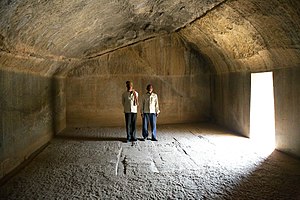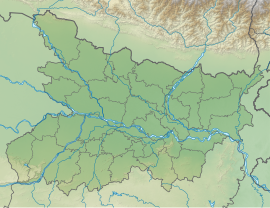Lomas Rishi Cave
| Lomas Rishi Cave | |
|---|---|
| District | Jehanabad district |
| Location | |
| Location | Sultanpur |
| State | Bihar |
| Country | India |
| Geographic coordinates | 25°00′23.2″N 85°03′52.3″E / 25.006444°N 85.064528°E |
| Architecture | |
| Style | Rock-cut cave |
The Lomas Rishi Cave, also called the Grotto of Lomas Rishi, is one of the man-made
The hut-style facade at the entrance to the cave is the earliest survival of the
According to Pia Brancaccio, the Lomas Rishi cave, along with nearby
First is a large hall, entered at the side and rectangular in shape measuring 9.86x5.18m, which functioned as an assembly hall. Further inside is a second hall, smaller in size, which is a semi-hemispherical room, 5m in diameter, with a roof in the form of a dome, and which is accessed from the rectangular room by a narrow rectangular passage.[7] The interior surfaces of the chambers are very finely finished.[8]
Location

Lomas Rishi Cave is carved into the hard monolithic granite rock face of Barabar hills, flanked to its left by the smaller Sudama cave.
History
During the reign of Mauryan emperor Ashoka, Lomas Rishi Cave was excavated and gifted to the Ajivikas monks. It is dated to the 3rd century BC.[12] Additional caves followed in the same granite hills, all in the 3rd century BC, based on the inscriptions found in the caves. The other six caves are (i) Karna Chaupar, (ii) Sudama Cave, (iii) Vishmitra Cave, (iv) Gopi Cave, (v) Vapiyaka Cave, and (vi) Vadathika Cave. The last three are on the Nagarjuni Hill east of the Barabar Hill.[13]

Burgess, in his cave temple survey of 19th-century, considered the Ajivika Lomas Rishi cave to an anchor milestone for cave chronology. According to Pia Brancaccio, the Lomas Rishi cave, along with nearby Sudama cave, is considered by many scholars to be "the prototype for the Buddhist caves of the western Deccan, particularly the chaitya hall type structure built between 2nd century BC and 2nd-century AD.
According to Arthur Basham, the elephant and other motifs carved at the entrance caitya arch and the walls of the Lomas Rishi cave are those of Ajivika, and this taken with the inscription of Ashoka giving nearby caves to them, suggests they were the original inhabitants. They abandoned the caves at some point, then Buddhists used it because there are the Bodhimula and Klesa-kantara inscriptions in this cave's door jamb. Thereafter a Hindu king named Anantavarman, of Maukhari dynasty, dedicated a Krishna murti to the cave, states Basham, in the 5th or 6th century. This is evidenced by the Sanskrit inscription found on the arch.[15][16]
E. M. Forster based the important scene in the "Marabar Caves" in his novel A Passage to India (1924) on these caves, which he had visited.[17]
Features

This cave has an arched facade that probably imitates contemporary wooden architecture. On the periphery of the door, along the curve of the architrave, a line of elephants advances in the direction of stupas emblems.
- Inscriptions
Lomas Rishi has no Ashoka inscription, perhaps because it has never been completed due to structural rock slide problems.[22] It is generally considered, however, that it was also created around 250 BC, like the other caves, because of the similarity of the internal structure and the degree of finish of the rock, the walls being perfectly polished, with the exception of the vault whose digging was interrupted. On the other hand, it has a much later inscription of Anantavarman above the entrance, from the 5th century of our era.
- Terminal event
According to Gupta, the theory that Lomas Rishi would not have received Ashoka's inscription because it was in a state of incompleteness, is undermined by the fact that the cave of Vivaskarma, another cave of Barabar, although it is not finished, was nevertheless consecrated by Ashoka.[18] The consecration of a cave could therefore be done in the course of work. This could imply that Lomas Rishi, with its bas-reliefs, actually post-dates Ashoka's reign.
Gupta actually believes that Lomas Rishi post-dates both Ashoka and his grandson Dasaratha, and would have been built at the end of the Maurya Empire, under the reign of its last Emperor
-
Entrances of Sudama Cave, and further, Lomas Rishi Cave, Barabar Hill.
-
Plan of the cave.
-
Volume representation of Lomas Rishi Cave. The digging of the vault has never been finished.
-
Entrance to the cave.
-
Development of the Chaitya Arch from Lomas Rishi Cave on, from a book by Percy Brown.
-
Wooden architecture reproduced in stone.
Inscription of Anantavarman (5-6th century CE)
Several Hindu inscriptions of the
| Translation in English | Original in Sanskrit (original text of Lomas Rishi Cave) |
|---|---|
|
Om! He, Anantavarman, who was the excellent son, captivating the heart of mankind, of the illustrious Sardaula, and who, possessed of very great virtues, adorned by his own (high) birth in the family of Maukhari kings, - him, of unsullied fame, with joy caused to be made, as if it were his own fame represented in bodily form in the world, this beautiful image, placed in (this) cave of the mountain Pravaragiri, of the (god) Krishna. (Line 3.) - The illustrious Sardula, of firmly established fame, the best among chieftains, became the ruler of the earth, he who was a very death to hostile kings; who was a tree the fruits of which were the (fulfilled) wishes of his favourites; who was the torch of the family of the warrior caste, which is glorious through waging many battles; (and) who, charming the thoughts of lovely women, resembled (the god) Smara. (L. 5.) - On whatsoever enemy the illustrious king Sardula casts in anger his scowling eye, the expanded and tremulous and clear and beloved pupil of which is red at the comers between the uplifted brows,— on him there falls the death-dealing arrow, discharged from the bowstring drawn up to (his) ear, of his son, the giver of endless pleasure, who has the name of Anantavarman. Corpus Inscriptionum Indicarum, Fleet p.223 |
Notes
- ^ ISBN 9780984404308.
- ISBN 978-0199644650, page 654
- ISBN 978-1899579549, pp. 207-208
- ^ Basham 1951, pp. 240–261, 270–273.
- ^ Harle (1994), 24-25; Michell (1989), 217-218
- ^ ISBN 978-90-04-18525-8.
- ISBN 978-0-670-80696-6.
- ISBN 978-0-300-06217-5.
- ^ "Sudama [and] Lomas Rishi Caves at Barabar [Hills], Gaya". Online Gallery:British Library.
- ^ "Barabar Caves". Official website of Bihar Tourism. Archived from the original on 19 July 2015.
{{cite web}}: CS1 maint: bot: original URL status unknown (link) - ISBN 978-92-3-102812-0.
- ^ Michell (1989), 217-218
- ^ Sir Alexander Cunningham (1871). Four Reports Made During the Years, 1862-63-64-65. Government Central Press. pp. 43–52.
- ISBN 978-0-300-06217-5.
- ^ ISBN 978-81-208-1204-8.
- ISBN 978-1-317-53852-3.;For more on Maukhari dating, see: Maukhari dynasty, Encyclopaedia Britannica
- ISBN 978-81-269-0750-2. Retrieved 8 January 2015.
- ^ ISBN 9788176467667. Retrieved 10 April 2023.
- ^ a b Harle 1994.
- ^ a b Michell 1989.
- ^ "Entrance to the Lomas Rishi Cave, Barabar Hills 100344b". Online Gallery: The British Library.
- ^ Buddhist Architecture par Huu Phuoc Le p.102
References
- Basham, A.L. (1951). History and Doctrines of the Ājīvikas (2nd ed.). Delhi, India: Moltilal Banarsidass (Reprint: 2002). ISBN 81-208-1204-2. originally published by Luzac & Company Ltd., London, 1951.
- Balcerowicz, Piotr (2015). Early Asceticism in India: Ājīvikism and Jainism (1st ed.). Routledge. p. 368. ISBN 9781317538530.
- Warder, Anthony K. (1998). "Lokayata, Ajivaka, and Ajnana Philosophy". A Course in Indian Philosophy (2nd ed.). Delhi: Motilal Banarsidass Publishers. pp. 32–44. ISBN 9788120812444.
- Harle, J.C. (1994). The Art and Architecture of the Indian Subcontinent. Pelican History of Art (2nd ed.). Yale University Press. ISBN 0300062176.
- Michell, George (1989). The Penguin Guide to the Monuments of India, Volume 1: Buddhist, Jain, Hindu. Penguin Books. ISBN 0140081445.
- Jarzombek, Mark M. (27 May 2014). Architecture of First Societies: A Global Perspective. John Wiley & Sons. ISBN 978-1-118-42105-5.










